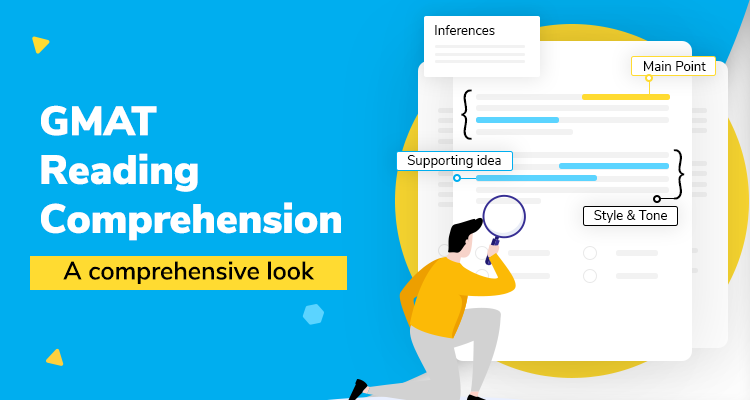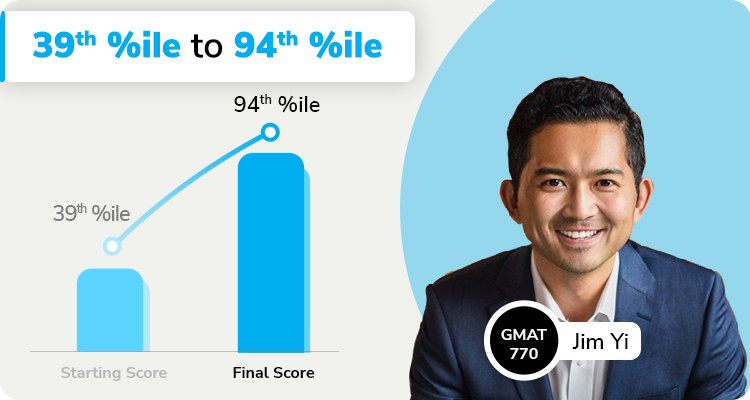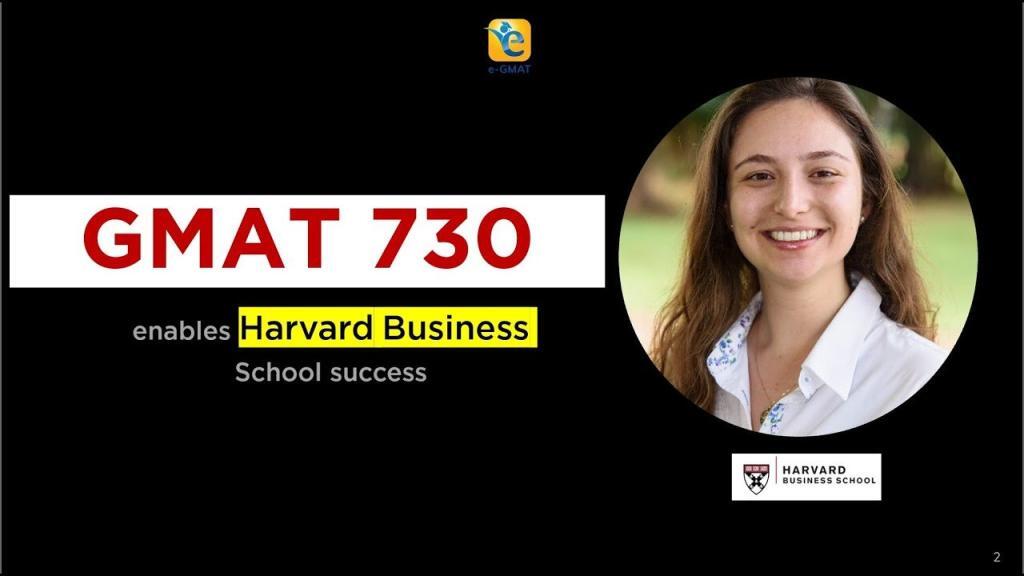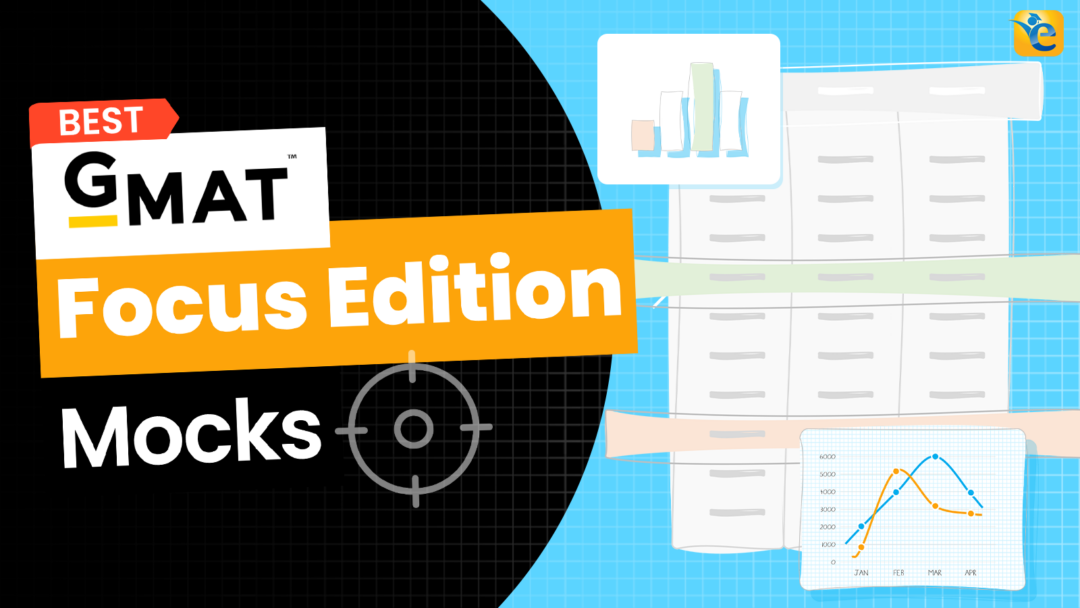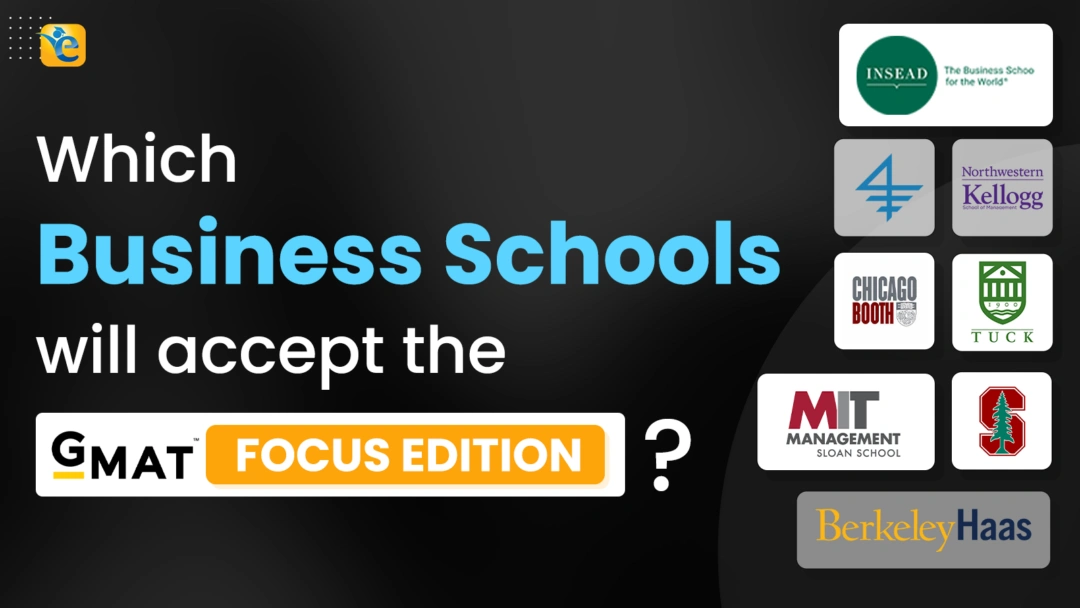This article provides a complete overview of the GMAT RC. You will learn everything you need to know about the GMAT Reading Comprehension, what it tests, the skills required to ace it, and a whole list of different GMAT RC sample questions for your practice!
GMAT Reading Comprehension – An overview
Mention this very special subsection – “GMAT Reading Comprehension” (RC) and watch most GMAT test takers cringe. But at e-GMAT, we transform this “cringe” to “crush.” It does not matter whether one possesses a low starting ability as did Rafaella (30th percentile) or a high starting ability as did Jim (GMAT 770 scorer); we have tools and teachings that can propel anyone’s ability in RC to the 90th percentile. But before that, let us first understand the function of this sub-section in the GMAT so that we can acknowledge and appreciate its contributions to becoming good managers.
If you’re looking for score improvement strategies for GMAT RC, here’s a detailed article!
Outline of the Article
Here’s a rundown of what all we will talk about in this article to keep our promise:
- 1. Why listen to us?
- 2. What does GMAT Reading Comprehension test?
- 3. Types of questions in GMAT Reading Comprehension
- GMAT Reading Comprehension Practice Question #1 – Main Point
- GMAT RC Practice Question #2 – Detail
- GMAT RC Practice Question #3 – Inference
- GMAT Reading Comprehension Practice Question #4 – Function
- GMAT Reading Comprehension Practice Question #5 – Style and Tone
- Further Reading – GMAT Reading Comprehension
- FAQs about GMAT Reading Comprehension – What it tests + Sample Practice RC Questions
Our Credibility
Why should you listen to or believe in us for what we are going to present? You can look up GMAT Club, our YouTube channel, LinkedIn, et al., to hear what GMAT test takers say about our processes and how e-GMAT has been instrumental in their admission to some of the best institutes for MBA such as Stanford, Harvard, Wharton, etc.
What does GMAT RC test?
In this section, we will talk about why this sub-section is part of this global test so that you can embrace this sub-section with complete positivity. Do remember that attitude determines the altitude.

Types of questions
We will briefly describe the types of questions presented in RC. This knowledge is essential to inculcate a scientific approach to reading and comprehending every RC passage, irrespective of your comfort level with the topic.
Before we get into each of these sections in detail, let us address another important question you might have about the reading comprehension GMAT:
How many reading comprehension questions are on the GMAT?
About one-third of the 36 questions that make up the GMAT Verbal section are RC questions. You will find around 4 RC passages, with 3-4 questions each, in the GMAT Verbal section. The rest of the questions are from critical reasoning and sentence correction.
1. Why listen to us?
Quite simply because our strategies deliver results. The promise of taking you to the 90th percentile ability in RC comes from the fact that we have done it in the past, and we continue to do so. In 2021, e-GMAT accounted for more than 50% of all 700+ GMAT scores reported on the GMAT Club. In other words, our students reported more success than did students of all other GMAT prep companies combined. Our students vouch for our guidance in RC. While the stress on one-pointed attention in comprehending the passage worked for Nithya (GMAT Score 760, V40), our reading strategies worked wonders for Varun (GMAT Score 740).
For more such inspiring statements, please watch this video:
If you are planning to take the GMAT, we can help you with a personalized study plan and give you access to quality online content to prepare. We are the most reviewed GMAT prep company on gmatclub with more than 2400 reviews and are the only prep company that has delivered more than 700+ scores than any other GMAT club partner. Why don’t you take a free trial and judge for yourself?
2. What does GMAT Reading Comprehension test?
Before we delve into what is tested in the RC section, let’s first understand why this sub-section is part of this global test. Managers must read many reports, churn information, consider possible implications, and then decide on a course of action. So, this sub-section primes the prospective managers for their future responsibilities.
Now, let’s hear from the horse’s mouth what the GMAC measures through this sub-section and why it is relevant for managers-in-making to undergo the “ordeal” of mastering this sub-section. The GMAT Official Guide, in its explanation for this sub-section, mentions under the heading “What is measured” the following points:
The GMAT reading comprehension questions evaluate your ability to do the following:
- Understand complex, sophisticated nontechnical writing.
- Understand the purposes and functions of passage components and the logical and rhetorical relationships among concepts and among pieces of information.
- Draw inferences from facts and statements.
- Understand and follow the development of quantitative concepts as they are presented in written material.
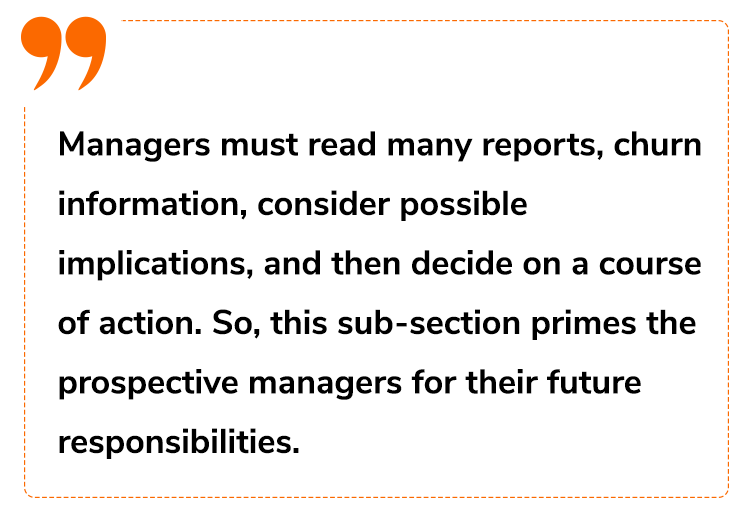
Let’s now decode all these points to understand the implications of mastering RC in the actual work environment.
- Understand Complex, Sophisticated Nontechnical Writing.
As already mentioned, managers and leaders must read a plethora of reports from various fields of activities. One may not be well-versed in all such areas, but one is undoubtedly expected to understand the information presented through a formal, nontechnical report. Whether a report merely explains a mechanism, presents an evaluation with pros and cons, or mentions a historical event, a shrewd manager must understand the recommendations by reading the report correctly and comprehending the information accurately. The RC passages prep us to do exactly so. Various topics discussed through passages are geared to help us become involved readers who can make sense of any well-written piece of literature.
- Understand the Purposes and Functions of Passage Components and the Logical and Rhetorical Relationships Among Concepts and Among Pieces of Information.
This point is quite loaded. So, let’s break it down bit by bit. An RC passage is written with a unified theme. To clearly put across the idea, the author may use various components such as examples, case studies, comparisons, positives & negatives, and so forth. The reader must be able to comprehend why a particular component has been used at a particular point in the passage and how it aids our understanding of the passage.
An RC passage may consist of a few paragraphs that flow in a logical pattern to discuss the topic at hand. Every passage is well-rounded, complete with every piece of information needed to decipher the content. Hence, one needs the skill to identify logical transitions between sentences and paragraphs to understand the logical flow of the passage and assimilate the information as one continues to read until the end.
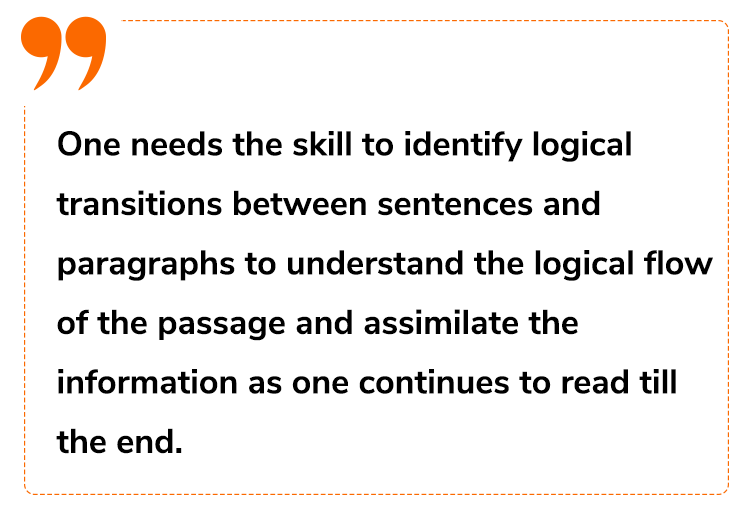
- Draw Inferences from Facts and Statements.
Every report may not have every bit of information mentioned explicitly. The ability to draw logical inferences by analyzing various kinds of information in the given text is a skill that plays an integral and significant role in RC. For example, if the passage says, “Every manager in the company is required to use a blue -pen, and Jack is the marketing manager in the company,” we can safely infer that Jack also uses a blue pen. Drawing inferences continually as one reads the passage keeps the reader involved and focused on the topic discussed, facilitating optimum comprehension as only those who thoroughly comprehend the information can draw correct inferences.
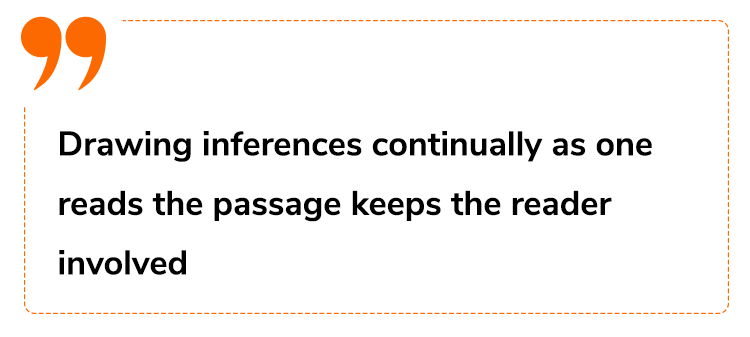
- Understand and Follow the Development of Quantitative Concepts as they are presented In Written Material.
Solving mathematical problems is NOT part of the Verbal Reasoning section. However, a passage may contain quantitative information through such expressions as most, many, all, none, etc. These expressions have quantitative connotations that must thoroughly be understood in the context of the given topic. RC passages comprise business-related topics that may mention percentages, statistical data, proportions, etc., that the reader must be able to interpret and decipher correctly without any technical knowledge. For example, if the passage says, “Everyone in the company uses a blue pen,” we must understand that 100% of employees use blue pens.
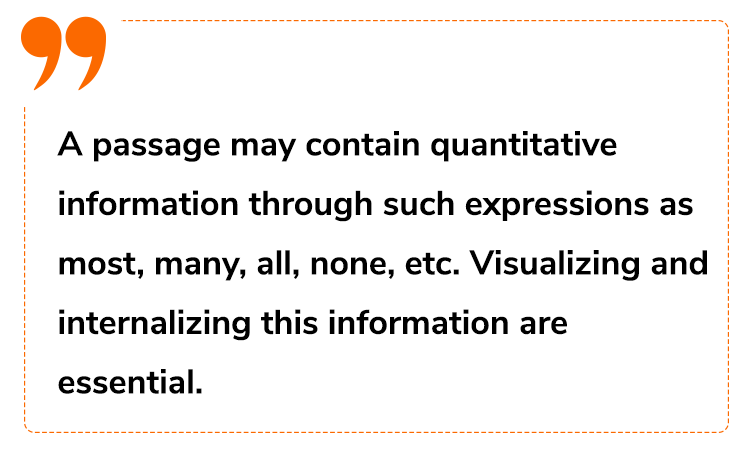
3. GMAT Reading Comprehension – Types of questions
This section is intimately connected to the preceding section because skills measured in GMAT Reading Comprehension are tested through certain question types. We can divide these question types into the following broad and sub-categories:
- Primary question types
- Main point
- Detail/Supporting idea
- Inference
- Secondary question types
- Function
- Application
- Style and Tone
Here are the skills tested through each of these question types:
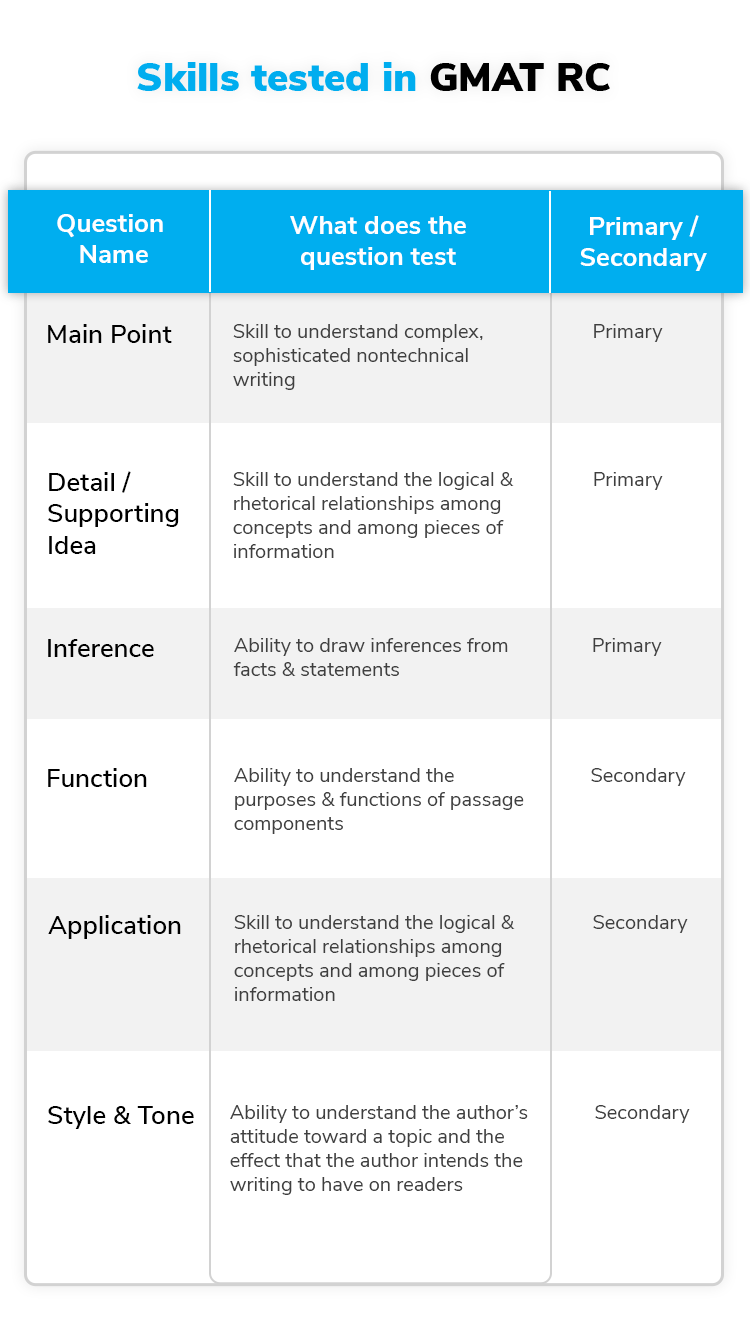
Now, let us understand each of these question types in detail sample reading comprehension practice questions of each type:
3.1 Main Point RC Questions
A GMAT Reading Comprehension passage is a complete “story” written with a unified purpose. This unified purpose or the central theme is sometimes presented directly in the passage or needs to be inferred based on the information presented in the passage. A Main Point Question asks the test takers to identify the central purpose with which the passage has been written. Almost every passage contains a Main Point Question and hence it is a Primary question type.
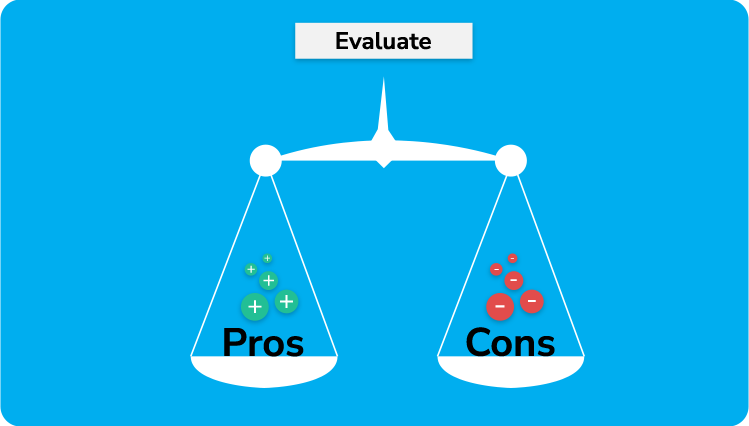
This question type corresponds to the skill mentioned in section (2.1) above. One can answer the Main Point question only when one thoroughly understands why the passage has been written and what kind of information it imparts. For example, if the passage discusses a topic by mentioning its merits and demerits, then we certainly know that the passage evaluates the topic discussed. An answer choice that says that the author merely discusses or explains the topic will not be the correct answer.
GMAT Reading Comprehension Practice Question #1 – Main Point
There are two theories that have been used to explain ancient and modern tragedy. Neither quite explains the complexity of the tragic process or the tragic hero, but each explains important elements of tragedy, and, because their conclusions are contradictory, they represent extreme views.
The first theory states that all tragedy exhibits the workings of external fate. Of course, the overwhelming majority of tragedies do leave us with a sense of the supremacy of impersonal power and of the limitation of human effort. But this theory of tragedy is an oversimplification, primarily because it confuses the tragic condition with the tragic process: the theory does not acknowledge that fate, in a tragedy, normally becomes external to the hero only after the tragic process has been set in motion. Fate, as conceived in ancient Greek tragedy, is the internal balancing condition of life. It appears as external only after it has been violated, just as justice is an internal quality of an honest person, but the external antagonist of the criminal. Secondarily, this theory of tragedy does not distinguish tragedy from irony. Irony does not need an exceptional central figure: as a rule, the more ignoble the hero the sharper the irony, when irony alone is the objective. It is heroism that creates the splendor and exhilaration that is unique to tragedy. The tragic hero normally has an extraordinary, often a nearly divine, destiny almost within grasp, and the glory of that original destiny never quite fades out of the tragedy.
The second theory of tragedy states that the act that sets the tragic process in motion must be primarily a violation of moral law, whether human or divine; in short, that the tragic hero must have a flaw that has an essential connection with sin. Again it is true that the great majority of tragic heroes do possess hubris, or a proud and passionate mind that seems to make the hero’s downfall morally explicable. But such hubris is only the precipitating agent of catastrophe, just as in comedy the cause of the happy ending is usually some act of humility, often performed by a noble character who is meanly disguised.
The primary purpose of the passage is to:
A. compare and criticize two theories of tragedy
B. develop a new theory of tragedy
C. summarize the thematic content of tragedy
D. reject one theory of tragedy and offer another theory in its place
E. distinguish between tragedy and irony
3.2 Detail or Supporting Idea RC Questions
Detail questions test one’s ability to decipher information directly mentioned in the passage and often contain the phrase “according to the passage…”. The skill mentioned in section 2.2 – Understand… the logical and rhetorical relationships among concepts and among pieces of information – is measured through Detail questions.
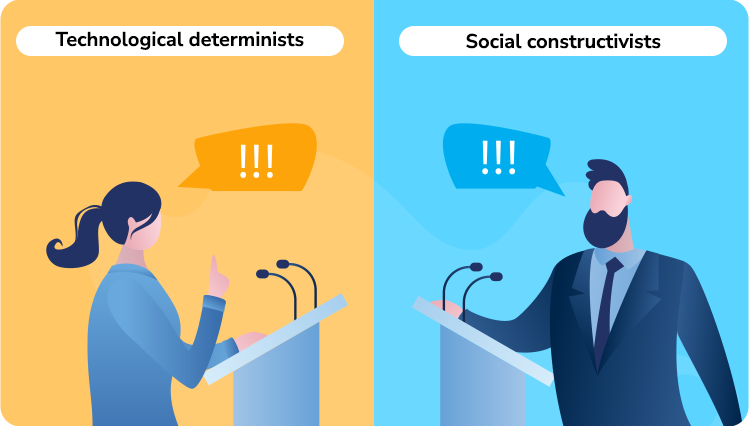
For example, the question stem may read, “According to the passage, how do the social constructivists undermine the importance of technological determinists?” To answer this question correctly, we must know which part of the passage deals with this information. Thoroughly comprehending and analyzing the pertinent information leads one to the correct answer. Often, the Detail questions pertain to information explicitly presented in the passage. Every passage contains between one and three of these questions. So, this again is a Primary question type.
GMAT RC Practice Question #2 – Detail
Jon Clark’s study of the effect of the modernization of a telephone exchange on exchange maintenance work and workers is a solid contribution to a debate that encompasses two lively issues in the history and sociology of technology: technological determinism and social constructivism.
Clark makes the point that the characteristics of a technology have a decisive influence on job skills and work organization. Put more strongly, technology can be a primary determinant of social and managerial organization. Clark believes this possibility has been obscured by the recent sociological fashion, exemplified by Braverman’s analysis, that emphasizes the way machinery reflects social choices. For Braverman, the shape of a technological system is subordinate to the manager’s desire to wrest control of the labor process from the workers. Technological change is construed as the outcome of negotiations among interested parties who seek to incorporate their own interests into the design and configuration of the machinery. This position represents the new mainstream called social constructivism.
The constructivists gain acceptance by misrepresenting technological determinism: technological determinists are supposed to believe, for example, that machinery imposes appropriate forms of order on society. The alternative to constructivism, in other words, is to view technology as existing outside society, capable of directly influencing skills and work organization.
Clark refutes the extremes of the constructivists by both theoretical and empirical arguments. Theoretically he defines “technology” in terms of relationships between social and technical variables. Attempts to reduce the meaning of technology to cold, hard metal are bound to fail, for machinery is just scrap unless it is organized functionally and supported by appropriate systems of operation and maintenance. At the empirical level Clark shows how a change at the telephone exchange from maintenance-intensive electromechanical switches to semi-electronic switching systems altered work tasks, skills, training opportunities, administration, and organization of workers. Some changes Clark attributes to the particular way management and labor unions negotiated the introduction of the technology, whereas others are seen as arising from the capabilities and nature of the technology itself. Thus Clark helps answer the question: “When is social choice decisive and when are the concrete characteristics of technology more important?”
According to the passage, constructivists employed which of the following to promote their argument?
(A) Empirical studies of business situations involving technological change
(B) Citation of managers supportive of their position
(C) Construction of hypothetical situations that support their view
(D) Contrasts of their view with a misstatement of an opposing view
(E) Descriptions of the breadth of impact of technological change
3.3 Inference based RC Questions
One of the most frequently asked and feared question types, Inference questions, test the ability of the test takers to draw logical inferences from the information stated in the passage. According to the GMAT Official Guide, Inference questions measure your ability to understand an author’s intended meaning in parts of a passage where the meaning is only suggested. Clearly, this instruction directly relates to section 2.3 – Draw inferences from facts and statements – a skill extensively tested in RC. The number of Inference questions in a passage may vary from one to 3. So, this is undoubtedly a Primary question type.
The phrasing of Inference questions includes words such as infer, inference, imply, implications, etc., to clarify the type of question. For example, “What can be inferred of the currently conducted clinical trials?” The test taker must consider all information of this kind of clinical trial, make logical deduction/s, and then choose the answer that comes closest to the deduction they made.
GMAT RC Practice Question #3 – Inference
Because the framers of the United States Constitution (written in 1787) believed that protecting property rights relating to inventions would encourage the new nation’s economic growth, they gave Congress—the national legislature—a constitutional mandate to grant patents for inventions. The resulting patent system has served as a model for those in other nations. Recently, however, scholars have questioned whether the American system helped achieve the framers’ goals. These scholars have contended that from 1794 to roughly 1830, American inventors were unable to enforce property rights because judges were “antipatent” and routinely invalidated patents for arbitrary reasons. This argument is based partly on examination of court decisions in cases where patent holders (“patentees”) brought suit alleging infringement of their patent rights. In the 1820s, for instance, 75 percent of verdicts were decided against the patentee. The proportion of verdicts for the patentee began to increase in the 1830s, suggesting to these scholars that judicial attitudes toward patent rights began shifting then.
Not all patent disputes in the early nineteenth century were litigated, however, and litigated cases were not drawn randomly from the population of disputes. Therefore the rate of verdicts in favor of patentees cannot be used by itself to gauge changes in judicial attitudes or enforceability of patent rights. If early judicial decisions were prejudiced against patentees, one might expect that subsequent courts—allegedly more supportive of patent rights—would reject the former legal precedents. But pre-1830 cases have been cited as frequently as later decisions, and they continue to be cited today, suggesting that the early decisions, many of which clearly declared that patent rights were a just recompense for inventive ingenuity, provided a lasting foundation for patent law. The proportion of judicial decisions in favor of patentees began to increase during the 1830s because of a change in the underlying population of cases brought to trial. This change was partly due to an 1836 revision to the patent system: an examination procedure, still in use today, was instituted in which each application is scrutinized for its adherence to patent law. Previously, patents were automatically granted upon payment of a $30 fee.
The passage implies that which of the following was a reason that the proportion of verdicts in favor of patentees began to increase in the 1830s?
A. Patent applications approved after 1836 were more likely to adhere closely to patent law.
B. Patent laws enacted during the 1830s better defined patent rights.
C. Judges became less prejudiced against patentees during the 1830s.
D. After 1836, litigated cases became less representative of the population of patent disputes.
E. The proportion of patent disputes brought to trial began to increase after 1836.
Additional: This passage is discussed as a part of this YT session we did.
Test takers generally dread Inference questions. However, at e-GMAT, we equip students to deal with such questions with utmost clarity and confidence. Please watch the Free RC Session, which we conduct every month, to learn how to solve Inference questions with ease.
3.4 Function GMAT RC Questions
This question type asks the purpose or the intent behind mentioning a word, a phrase, a sentence, an example, or a paragraph. The question often contains the expression, “The author mentions ABC in the passage to….” OR “What is the purpose for using ABC in the passage”? So, depending on the entity – whether it is an example to illustrate the topic discussed or a piece of information to bolster or complement particular information, one makes the proper selection of an answer choice. The function of the Function questions is to measure how well one can follow the thought process of the author of the passage in presenting relevant contextual information for a better understanding of the topic discussed.
This question type relates to section 2.2 – Understand the purposes and functions of passage components. To answer these questions correctly, a thorough understanding of the intent behind mentioning an entity is imperative. This question type falls in the Secondary question category because of its infrequency (not tested very frequently).
GMAT Reading Comprehension Practice Question #4 – Function
Jon Clark’s study of the effect of the modernization of a telephone exchange on exchange maintenance work and workers is a solid contribution to a debate that encompasses two lively issues in the history and sociology of technology: technological determinism and social constructivism.
Clark makes the point that the characteristics of a technology have a decisive influence on job skills and work organization. Put more strongly, technology can be a primary determinant of social and managerial organization. Clark believes this possibility has been obscured by the recent sociological fashion, exemplified by Braverman’s analysis, that emphasizes the way machinery reflects social choices. For Braverman, the shape of a technological system is subordinate to the manager’s desire to wrest control of the labor process from the workers. Technological change is construed as the outcome of negotiations among interested parties who seek to incorporate their own interests into the design and configuration of the machinery. This position represents the new mainstream called social constructivism.
The constructivists gain acceptance by misrepresenting technological determinism: technological determinists are supposed to believe, for example, that machinery imposes appropriate forms of order on society. The alternative to constructivism, in other words, is to view technology as existing outside society, capable of directly influencing skills and work organization.
Clark refutes the extremes of the constructivists by both theoretical and empirical arguments. Theoretically he defines “technology” in terms of relationships between social and technical variables. Attempts to reduce the meaning of technology to cold, hard metal are bound to fail, for machinery is just scrap unless it is organized functionally and supported by appropriate systems of operation and maintenance. At the empirical level Clark shows how a change at the telephone exchange from maintenance-intensive electromechanical switches to semielectronic switching systems altered work tasks, skills, training opportunities, administration, and organization of workers. Some changes Clark attributes to the particular way management and labor unions negotiated the introduction of the technology, whereas others are seen as arising from the capabilities and nature of the technology itself. Thus Clark helps answer the question: “When is social choice decisive and when are the concrete characteristics of technology more important?”
The author of the passage uses the expression “are supposed to” primarily in order to
(A) suggest that a contention made by constructivists regarding determinists is inaccurate
(B) define the generally accepted position of determinists regarding the implementation of technology
(C) engage in speculation about the motivation of determinists
(D) lend support to a comment critical of the position of determinists
(E) contrast the historical position of determinists with their position regarding the exchange modernization
3.5 Application RC Questions
According to the GMAT Official Guide, “Application questions measure your ability to discern relationships between situations or ideas presented in the passage and other situations or ideas beyond the direct scope of the passage.” Obviously, this information gain relates to 2.2 –Understand… the logical and rhetorical relationships among concepts and among pieces of information. We can clearly fathom the importance of this skill as it is tested through multiple question types. Application questions are rare and hence can be categorized as a Secondary question.
Aryan chose the e-GMAT course after reading positive reviews on GMAT Club and decided to take the free trial. That’s when he felt that the course could finally help him get to his maximum potential. He trusted the course and followed his mentor’s advice diligently., This ultimately helped him reach the 97th percentile on the GMAT.
If you are planning to take the GMAT, we can help you with a personalized study plan and give you access to quality online content to prepare. We are the most reviewed GMAT prep company on gmatclub with more than 2465 reviews and are the only prep company that has delivered more than 700+ scores than any other GMAT club partner. Why don’t you take a free trial and judge for yourself?
3.6 Style and Tone RC Questions
Yet another sporadic question category and hence a Secondary question type, Style and Tone questions measure one’s ability to identify the author’s attitude toward a topic and the effect that the author intends the writing to have on readers. The style and tone of the passage/author are very implicit to the passage and depend on the reader’s level of comprehension. Answering this type of question requires the skill mentioned in section 2.1 – Understand complex, sophisticated nontechnical writing. The overall understanding of the passage is the only way to decipher the author’s tone. For example, if the author presents the critics’ views and explicitly agrees with the same, we understand that the author is favorable to the critic.
GMAT Reading Comprehension Practice Question #5 – Style and Tone
Labeling Zora Neale Hurston “a writer of the Harlem Renaissance” is a characterization that may, at first glance, obscure, rather than clarify, the particularities of her career. The Harlem Renaissance was a spirit more than a movement, and because a spirit is ephemeral, generalizations about the Harlem Renaissance and its writers are either too hard or too easy. They have come easily enough to a whole generation of critics, but their pithy summaries seldom reflect the wide divisions between Blacks and Whites, the Black intelligentsia and Black workers, Black writers and their middle- class audience, that marked the era. When one studies in depth the phenomenon of what was then called the Negro Renaissance or the New Negro Renaissance, and what is now called the Harlem Renaissance, one comes away with a bewildering complex of notions, statements, affirmations, and manifestos. Although there is general agreement that the Harlem Renaissance is bounded by the 1918 armistice ending the First World War and the beginning of the Great Depression in 1930, some historians have stretched the boundaries to before the war (1914) and after Franklin Delano Roosevelt’s second term (1941). There has been a wide- spread tendency to regard the Harlem Renaissance as a monolithic cultural movement, capable of reduction to one orthodoxy or another or to a set of characteristic principles. This presumption reflects the bias in most American scholarship that postulates Black people as a united entity and then poses theories ignoring individuation of thought and feeling. Sometimes, however, an individual career can be best assessed in the context of an age, and this is largely the case with the writer and anthropologist Zora Neale Hurston. She spends exactly two para- graphs on the Renaissance in her autobiography, and her other writing, public and private, offers a very little discussion of what the Harlem Renaissance meant to her. Yet her part in the Renaissance is well-documented in the reminiscences of others, with unanimous agreement that she was one of the most memorable personages of the period. As Langston Hughes put it in The Big Sea, she “was certainly the most amusing” of the Harlem Renaissance artists, “full of side-splitting anecdotes, humorous tales, and tragicomic stories.” Hughes’s words should not imply that she was solely an entertainer. Although she was independent and scornful of literary movements, she shared in the historical and cultural forces that made the Harlem Renaissance an identifiable moment in American intellectual history, a part of a historical process that, as most critics recognize, altered Black life in America. She, in turn, responded to and helped to shape the aesthetic assumptions of that era. Between 1919 and 1930, Black writers were published in greater numbers than in any single decade in American life prior to the 1960’s. Hurston’s awareness of this literary ferment certainly con- tributed to her development as a writer.
According to the passage, Hurston’s attitude toward literary movements in general was
(A) bemused
(B) ambivalent
(C) indifferent
(D) disdainful
(E) belligerent
GMAT Reading Comprehension Questions- List
Here is a list of all the GMAT Reading comprehension questions we have discussed in this article:
- Practice Question 1- Main Point
- Practice Question 2- Detail
- Practice Question 3- Inference
- Practice Question 4- Function
- Practice Question 5- Style and Tone
Further Reading – GMAT Reading Comprehension
This brings us to the end of this article. But this is not all about GMAT RC that we want to share. Our follow-up article describes the core skills required to achieve the 90th percentile ability in GMAT Reading Comprehension, irrespective of where one starts from, the promise that we made right at the beginning of this article. Here is a little preview of what is in store for you to explore:
Core Skills Needed To Ace GMAT RC
In the follow-up article, we have described the core skills that one needs to inculcate for that glorious score in GMAT Reading Comprehension. The following core skills have been described in the follow-up article:
- Read & Comprehend
- Connect Sentences
- Summarize Passages
- Translate Answer Choice
In addition, you will also read all about the best practices and tools that one requires to excel in this sub-section. Added to them are Don’ts – how you should NOT prepare for RC – to safeguard you from the hurdles that might hinder your progress in RC.
So, what are you waiting for? Just embrace GMAT Reading Comprehension with enthusiasm and get working.
Happy Learning.
Aryan chose the e-GMAT course after reading positive reviews on GMAT Club and decided to take the free trial. That’s when he felt that the course could finally help him get to his maximum potential. He trusted the course and followed his mentor’s advice diligently., This ultimately helped him reach the 97th percentile on the GMAT.
If you are planning to take the GMAT, we can help you with a personalized study plan and give you access to quality online content to prepare. We are the most reviewed GMAT prep company on gmatclub with more than 2465 reviews and are the only prep company that has delivered more than 700+ scores than any other GMAT club partner. Why don’t you take a free trial and judge for yourself?
FAQs about GMAT Reading Comprehension – What it tests + Sample Practice RC Questions
As a GMAT aspirant, you might be wondering how to improve your score in GMAT RC?
Luckily, our Verbal experts have covered all the tips, dos, and don’ts to ace GMAT RC in this article! So go on, read and ace your GMT Verbal!
Here’s a detailed comprehensive post written by our top rated Verbal experts, for all those aspirants who are stuck with their GMAT Verbal preparation and are concerned about any of the following:
1. How to prepare for the Verbal Reasoning Section of the GMAT?
2. What skills to build in order to ace the GMAT Verbal section?
3. How to plan your preparation – the most efficient path to V40+ for YOU?
4. Dos and Don’ts: Common Pitfalls to avoid in the GMAT Verbal?
5. Where can I find a comprehensive list of free resources?
6. How to get started?
Here’s a detailed article that answers all the questions pertaining to GMAT Critical Reasoning, what it tests, sample questions, etc.
Here’s a detailed article that answers all the questions pertaining to GMAT Sentence Correction, what it tests, sample questions, etc.


